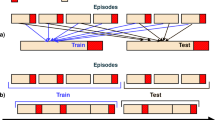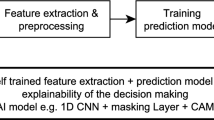Abstract
The data provided by cyber-physical production systems (CPPSs) to monitor their condition via data-driven predictive maintenance is often high dimensional and only a few fault and failure (FaF) examples are available. These FaFs can usually be detected in a (small) localized subset of data streams, whereas the use of all data streams induces noise that could negatively affect the training and prediction performance. In addition, a CPPS often consists of multiple similar units that generate comparable data streams and show similar failure modes. However, existing approaches for learning a similarity measure generally do not consider these two aspects. For this reason, we propose two approaches for integrating expert knowledge about class or failure mode dependent attributes into siamese neural networks (SNN). Additionally, we present an attribute-wise encoding of time series based on 2D convolutions. This enables that learned knowledge in the form of filters is shared between similar data streams, which would not be possible with conventional 1D convolutions due to their spatial focus. We evaluate our approaches against state-of-the-art time series similarity measures such as dynamic time warping, NeuralWarp, as well as a feature-based representation approach. Our results show that the integration of expert knowledge is advantageous and combined with the novel SNN architecture it is possible to achieve the best performance compared to the other investigated methods.
Access this chapter
Tax calculation will be finalised at checkout
Purchases are for personal use only
Similar content being viewed by others
References
Abanda, A., Mori, U., Lozano, J.A.: A review on distance based time series classification. Data Mining Knowl. Discov. 33(2), 378–412 (2018). https://doi.org/10.1007/s10618-018-0596-4
Assaf, R., Schumann, A.: Explainable deep neural networks for multivariate time series predictions. In: Proceedings of the Twenty-Eighth International Joint Conference on Artificial Intelligence, IJCAI-19, pp. 6488–6490 (2019)
Bergmann, R.: Experience Management: Foundations, Development Methodology, and Internet-Based Applications. Springer, Heidelberg (2002). https://doi.org/10.1007/3-540-45759-3
Berndt, D.J., Clifford, J.: Using dynamic time warping to find patterns in time series. In: KDD: Papers from AAAI Workshop, pp. 359–370. AAAI Press (1994)
Bromley, J., et al.: Signature verification using a “siamese” time delay neural network. IJPRAI 7(4), 669–688 (1993)
Christ, M., Braun, N., Neuffer, J., Kempa-Liehr, A.W.: Time series feature extraction on basis of scalable hypothesis tests. Neurocomputing 307, 72–77 (2018)
Goodman, D., James, P., Hofmeister, F.S.: Prognostics and Health Management: A Practical Approach to Improving System Reliability Using Condition-Based Data. Wiley (2019)
Fink, O., Wang, Q., Svensén, M., Dersin, P., Lee, W.J., Ducoffe, M.: Potential, challenges and future directions for deep learning in prognostics and health management applications. Eng. Appl. Artif. Intell. 92, 103678 (2020)
Grabocka, J., Schmidt-Thieme, L.: NeuralWarp: Time-Series Similarity with Warping Networks. CoRR abs/1812.08306 (2018)
Koch, G., Richard Zemel, R.S.: Siamese neural networks for one-shot image recognition. In: ICML, Lille, France (2015)
Guan, Q., Huang, Y., Zhong, Z., Zheng, Z., Zheng, L., Yang, Y.: Thorax disease classification with attention guided convolutional neural network. Pattern Recog. Lett. 131 (2019)
Guo, J., Li, Z., Li, M.: A review on prognostics methods for engineering systems. IEEE Trans. Reliab. 69(3), 1110–1129 (2020). https://doi.org/10.1109/TR.2019.2957965
Huang, X., Zanni-Merk, C., Crémilleux, B.: Enhancing deep learning with semantics: an application to manufacturing time series analysis. Procedia Comput. Sci. 159, 437–446 (2019)
Jia, X., Cai, H., Hsu, Y.M., Li, W., Feng, J., Lee, J.: A novel similarity-based method for remaining useful life prediction using kernel two sample test. In: Proceedings of the Annual Conference of the PHM Society (2019)
Jiang, W.: Time series classification: nearest neighbor versus deep learning models. SN Appl. Sci. 2(4), 1–17 (2020). https://doi.org/10.1007/s42452-020-2506-9
Klein, P., Bergmann, R.: Generation of complex data for ai-based predictive maintenance research with a physical factory model. In: 16th International Conference on Informatics in Control Automation and Robotics, pp. 40–50. SciTePress (2019)
Klein, P., Malburg, L., Bergmann, R.: FTOnto: a domain ontology for a Fischertechnik simulation production factory by reusing existing ontologies. In: Proceedings of the Conference LWDA, vol. 2454, pp. 253–264. CEUR-WS.org (2019)
Lapuschkin, S., Wäldchen, S., Binder, A., Montavon, G., Samek, W., Müller, K.-R.: Unmasking Clever Hans predictors and assessing what machines really learn. Nat. Commun. 10 (2019). https://doi.org/10.1038/s41467-019-08987-4
Lee, J., Bagheri, B., Kao, H.A.: A cyber-physical systems architecture for industry 4.0-based manufacturing systems. Manuf. Lett. 3, 18–23 (2015)
Lezoche, M., Panetto, H.: Cyber-Physical Systems, a new formal paradigm to model redundancy and resiliency. Enterprise Information Systems, pp. 1–22 (2018)
Luo, Y., Xiao, Y., Cheng, L., Peng, G., Yao, D.D.: Deep Learning-Based Anomaly Detection in Cyber-Physical Systems: Progress and Opportunities. CoRR abs/2003.13213 (2020)
Mai, C.K., Chevalier, R.: Equipment diagnostics based on comparison of past abnormal behaviors using a big data platform. In: Proceedings of the Annual Conference of the PHM Society (2016)
Pei, W., Tax, D.M.J., van der Maaten, L.: Modeling Time Series Similarity with Siamese Recurrent Networks. CoRR abs/1603.04713 (2016)
Ran, Y., Zhou, X., Lin, P., Wen, Y., Deng, R.: A Survey of Predictive Maintenance: Systems, Purposes and Approaches. CoRR abs/1912.07383 (2019)
Turney, P.D.: The Management of Context-Sensitive Features: A Review of Strategies. CoRR abs/cs/0212037 (2002)
Yeh, A.: More accurate tests for the statistical significance of result differences. arXiv preprint cs/0008005 (2000)
Zhang, A., Li, S., Cui, Y., Yang, W., Dong, R., Hu, J.: Limited data rolling bearing fault diagnosis with few-shot learning. IEEE Access 7, 110895–110904 (2019)
Author information
Authors and Affiliations
Corresponding author
Editor information
Editors and Affiliations
A Dataset
A Dataset
An overview of the classes and their distribution contained in the data set is shown in Table 3. Note that the case base used for evaluation, as described in Sect. 4.3, contains up to 150 examples from the training data set for each class, i.e. 150 for no_failure and every example of all other classes. The “txt” part of the label indicates the location of the component, i.e. the CPS, where the failure was simulated.
Rights and permissions
Copyright information
© 2020 Springer Nature Switzerland AG
About this paper
Cite this paper
Klein, P., Weingarz, N., Bergmann, R. (2020). Enhancing Siamese Neural Networks Through Expert Knowledge for Predictive Maintenance. In: Gama, J., et al. IoT Streams for Data-Driven Predictive Maintenance and IoT, Edge, and Mobile for Embedded Machine Learning. ITEM IoT Streams 2020 2020. Communications in Computer and Information Science, vol 1325. Springer, Cham. https://doi.org/10.1007/978-3-030-66770-2_6
Download citation
DOI: https://doi.org/10.1007/978-3-030-66770-2_6
Published:
Publisher Name: Springer, Cham
Print ISBN: 978-3-030-66769-6
Online ISBN: 978-3-030-66770-2
eBook Packages: Computer ScienceComputer Science (R0)




